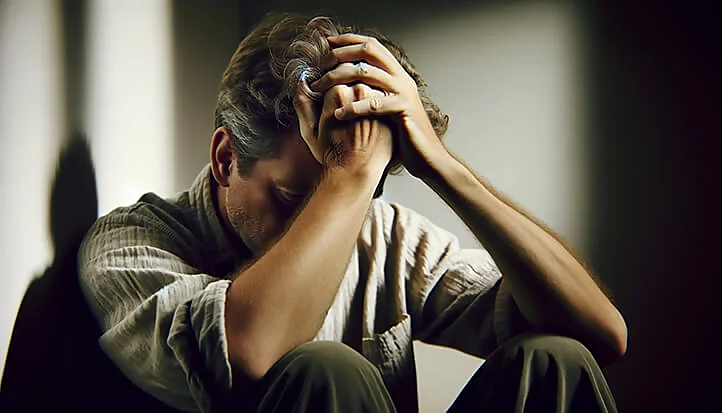Obsessive-Compulsive Disorder (OCD) is a mental illness characterized by the presence of intrusive thoughts (obsessions) and compulsive actions (compulsions). Obsessions are repetitive and unwanted thoughts, images, or impulses that cause anxiety or distress. Compulsions are repetitive actions or rituals performed in an attempt to alleviate the anxiety caused by obsessions. These symptoms can significantly affect the quality of life and daily functioning of a person.
Obsessive-Compulsive Disorder is a relatively common mental illness. Here are some key statistical data about the prevalence of OCD:
- Global prevalence. OCD affects about 2-3% of the world population over the course of a lifetime. This means that millions of people worldwide suffer from this condition.
- Onset of the disorder. OCD often begins in adolescence or early adulthood, although symptoms may appear in childhood. The average age of onset is typically around 19 years old.
- Gender differences. The prevalence of OCD is roughly equal between men and women, although some studies suggest that women may be more prone to this disorder.
- Chronic nature. Obsessive-Compulsive Disorder is a chronic condition, meaning it can last for many years or even a lifetime. For some people, the symptoms may be intermittent, while for others, they are persistent.
- Impact on quality of life. OCD can significantly affect quality of life, limiting a person’s ability to function in social, professional, or other important areas of life.
- Comorbid disorders. People with OCD often suffer from other mental disorders, such as anxiety disorders, depression, eating disorders, and tic disorders.

What is Obsessive-Compulsive Disorder?
Obsessive-Compulsive Disorder, known by its abbreviations OCD, is a complex mental condition that affects millions of people worldwide. Despite its wide prevalence, many aspects of this disorder remain misunderstood or surrounded by myths and misconceptions. At its core, it involves a struggle with internal obsessive thoughts and external compulsive actions that can seriously impact a person’s daily life.
The foundation of OCD lies in obsessions—intrusive, unwanted thoughts or impulses that constantly revolve in the mind. These thoughts often trigger anxiety or distress, creating a sense of urgency to perform certain actions or rituals known as compulsions. These compulsive actions, whether it’s constant handwashing or repeatedly checking locked doors, are performed in an attempt to relieve the discomfort caused by obsessions. However, the relief is usually temporary, creating a vicious cycle of intrusive thoughts and repetitive actions.
Understanding OCD requires a deep look not only at the outward manifestations of the disorder but also at the internal experience of those living with it. It is much more than just a habit or a quirk; it is a serious medical condition that has a significant impact on a person’s emotional well-being and daily activities.
Symptoms of OCD
Obsessive-Compulsive Disorder (OCD) is characterized by two primary types of symptoms: obsessions (intrusive thoughts) and compulsions (repetitive actions). Here is a detailed description of each type of symptom:
Obsessions (Intrusive Thoughts)
- Unwanted and repetitive thoughts. These may involve thoughts of violence, sexual, or religious themes, fears of contamination or getting dirty. They often cause significant discomfort or anxiety.
- Fears and doubts. Frequent worries about safety, fears of harming oneself or others, or excessive doubts about making the right decisions.
- Need for symmetry and precision. A desire for everything to be perfectly aligned or done in a specific way, to the point of obsession.
- Mental counting or repetition. Some people feel the need to repeat words, phrases, or prayers mentally to prevent unwanted events or situations.
Compulsions (Repetitive Actions)
- Checking. Repeatedly checking locks, switches, or appliances, often out of fear of causing a fire, gas leak, or harm to others.
- Counting and arranging. A strong need for things to be arranged in a certain way, or tasks to be performed in a strict sequence.
- Cleaning and washing. Excessive cleaning or handwashing, often due to fear of contamination or dirt.
- Hoarding. Difficulty discarding unnecessary or old items, regardless of their actual value.
- Repetition of certain actions. For example, entering and exiting a door, going up and down stairs a specific number of times, or until it feels “right.”
People with OCD may be aware that their obsessions and compulsions are irrational or excessive, but fighting against them often causes significant anxiety or physical discomfort. Symptoms can vary greatly between individuals in both specificity and intensity. It is important to note that only a qualified professional can diagnose “Obsessive-Compulsive Disorder” based on a clinical assessment of symptoms and their impact on a person’s life.
Differences Between Intrusive Thoughts and Compulsive Actions
In the context of Obsessive-Compulsive Disorder (OCD), it is important to understand the differences between intrusive thoughts (obsessions) and compulsive actions (compulsions), as they represent different aspects of the disorder:
Intrusive Thoughts (Obsessions)
- Internal experience. Obsessions are internal, repetitive, and unwanted mental images, thoughts, or impulses. They occur in a person’s mind and are invisible to others.
- Source of anxiety. These thoughts often cause significant discomfort, worry, or anxiety. A person may recognize their irrationality, yet they remain distressing and intrusive.
- Content of obsessions. Obsessions can include fears of contamination, fear of losing control, excessive doubts, concerns over order and symmetry, and thoughts of an aggressive or sexual nature.
Compulsive Actions (Compulsions)
- External behavior. Compulsions are repetitive actions or rituals performed by a person, often in response to obsessions. They are visible and can be noticed by others.
- Attempts to relieve anxiety. Compulsive actions are performed in an attempt to reduce the anxiety caused by obsessive thoughts, although the relief is often temporary.
- Types of compulsions. These include washing hands, checking things (e.g., locks or switches), arranging objects, counting, and repeating certain words or actions.
It is important to note that obsessions and compulsions are closely linked. Obsessions often cause anxiety or fear, leading to compulsive actions as an attempt to cope with these feelings. However, not all people with OCD experience both obsessions and compulsions—some may have only intrusive thoughts without visible actions, or vice versa.
Obsessive-Compulsive Disorder: Myths and Misconceptions
Obsessive-Compulsive Disorder (OCD) is surrounded by many myths, which can lead to a misunderstanding of the condition. Here are some of the most common misconceptions:
1. Myth: OCD is just about cleanliness and order.
- Reality: While frequent handwashing or a desire for order may be symptoms of OCD, the disorder is much more complex and encompasses a wide range of obsessions and compulsions that are not always related to cleanliness or order.
2. Myth: People with OCD just worry about trivial things.
- Reality: OCD is a serious mental disorder that causes significant distress and negatively affects quality of life. It is not simply a concern over minor issues, but deeply ingrained and distressing thoughts and actions.
3. Myth: People with OCD can just stop their compulsive actions if they want to.
- Reality: OCD is not a matter of willpower or choice. Compulsions are uncontrollable responses to obsessive thoughts, and stopping them without professional help can be extremely difficult.
4. Myth: People with OCD are always noticeable.
- Reality: Some forms of OCD can manifest internally, such as intrusive thoughts without visible compulsive actions. This means OCD is not always apparent to others.
5. Myth: OCD is a rare condition.
- Reality: OCD is fairly common; estimates suggest it affects between 2% and 3% of the global population.
6. Myth: OCD can only be treated with medication.
Reality: While medication can be effective for some people with OCD, psychotherapy, especially Cognitive Behavioral Therapy (CBT), is also a key component of treatment.
7. Myth: OCD is just part of someone’s personality.
- Reality: OCD is not a personality trait but a serious medical condition that requires professional treatment.
Understanding these myths and the reality of OCD is essential for correctly perceiving and approaching the treatment of Obsessive-Compulsive Disorder, as well as for providing support to those who face it.

The Impact of OCD on Daily Life
Living with obsessive-compulsive disorder can be a challenging experience, significantly affecting various aspects of everyday life. This disorder leaves its mark not only on a person’s emotions and inner world but also on their interactions with others. For many people with OCD, the constant struggle with obsessive thoughts and compulsive actions becomes a background that impacts work, relationships, social interactions, and overall quality of life.
Professional activities, social contacts, and even simple household tasks can become difficult due to OCD. Relationships with family, friends, and colleagues are also tested when a significant portion of time and energy is spent on daily rituals and anxieties. Understanding how OCD affects different areas of life is key to providing adequate support and developing effective coping strategies.
Obsessive-Compulsive Disorder and Personal Life
OCD affects not only those who directly suffer from this disorder but also their loved ones, including family, friends, and partners. Here are some examples of how this influence can manifest:
- Emotional distress. Obsessive thoughts and compulsive actions can cause significant stress and anxiety, which in turn affects a person’s emotional state. This often leads to irritability, low mood, or depression, negatively impacting interpersonal relationships.
- Impact on close relationships. Partners and family members may feel burdened by the need to adapt to the rituals and limitations imposed by OCD. They may struggle to understand and accept behaviors related to OCD, often leading to conflicts or tension in relationships.
- Limitation of social interactions. People with OCD may avoid social situations or certain places that trigger their obsessions or compulsions. This leads to social isolation and difficulties in maintaining friendships.
- Impact on sexual life. Sexual relationships may also be affected, especially if OCD is linked to obsessions about contamination or fear of infection. This leads to tension and problems in intimate relationships.
- Impact on parenting. Parents with obsessive-compulsive disorder may find it challenging to raise children due to their obsessions and compulsions. They may excessively worry about their children’s safety or health, putting pressure on both the children and the parenting process.
- Economic and household issues. OCD can affect a person’s ability to perform daily tasks, such as cleaning, shopping, or managing finances, leading to problems at home.
It is important to note that each case of OCD is unique, and the degree of impact on personal life and relationships can vary significantly. Understanding, support, and empathy from loved ones, as well as professional help, play an essential role in managing OCD and its impact on interpersonal relationships.
OCD and Professional Life
Obsessive-compulsive disorder can have a significant impact on a person’s professional life and career. Here’s how this manifests:
- Work performance. Obsessive thoughts and compulsive actions distract and slow down the completion of work tasks. A person with OCD may spend a lot of time repeating certain actions or struggling with intrusive thoughts, reducing their efficiency.
- Work relationships. Perfectionism, fear of making mistakes, or an obsessive need for order and control can create tension in relationships with colleagues. Colleagues may also not understand the reasons behind certain behaviors, often leading to misunderstandings and conflicts.
- Career growth. Due to difficulties with concentration, stress, and anxiety associated with OCD, a person may struggle with career advancement or finding a job.
- Workplace and working conditions. Some people with obsessive-compulsive disorder suffer from obsessive fears related to hygiene or germs, making their work in public places or open office spaces difficult and stressful.
- Psychological well-being. The constant tension and anxiety associated with OCD increase overall work-related stress, negatively affecting psychological well-being.
- Work absenteeism. OCD can lead to frequent absences from work due to the need to perform compulsive actions or due to stress caused by obsessions.
However, it’s important to note that OCD symptoms and their impact on work can vary significantly among individuals.
Social Aspects and Public Perception
Obsessive-compulsive disorder affects not only a person’s personal or professional life but also their social interactions and public perception. Here are some examples that highlight this:
- Misunderstanding and stereotypes. OCD is often misunderstood by society. Many people associate this disorder solely with excessive cleanliness or order, without realizing the complexity and seriousness of it. This leads to people with OCD feeling embarrassed or afraid to talk about their condition.
- Social isolation. Due to the fear of being misunderstood or judged, people with OCD often avoid social interactions and limit their social contacts. This can lead to social isolation and loneliness.
- Impact on education. Students with OCD may face difficulties in their studies due to interruptions caused by their obsessive thoughts or compulsive actions, affecting their academic achievements and social interactions in an educational setting.
- Media portrayal. The representation of OCD in media and popular culture is often simplified and stereotypical, exacerbating the misunderstanding of this disorder.
It is essential to conduct educational and awareness-raising efforts to increase society’s understanding of the complexity and seriousness of obsessive-compulsive disorder. This will help create a more supportive and understanding environment for people suffering from OCD.

Diagnosis and Treatment of OCD
Obsessive-compulsive disorder (OCD) is a complex and multifaceted mental illness that requires a careful and professional approach to diagnosis and treatment. The diversity of symptoms and the individual nature of their manifestation make the diagnostic process critically important for determining the most effective treatment path. A key aspect of managing OCD is understanding that while a complete cure may not always be possible, there are strategies and methods that can significantly improve a person’s quality of life.
Modern medicine offers a range of therapeutic approaches aimed at helping individuals cope with the symptoms of OCD. From carefully selected pharmacological solutions to various forms of psychotherapy, each treatment path has its own characteristics and can be adapted to the specific needs and circumstances of the patient. It is important to emphasize that successful treatment often requires a comprehensive approach, including not only medical intervention but also support from loved ones, as well as changes in lifestyle and daily habits.
Understanding the process of diagnosing and treating OCD is key not only for specialists but also for those facing this disorder. Receiving an accurate diagnosis and effective treatment can open the door to a better understanding of oneself and one’s condition, leading to a more fulfilling and satisfying life.
Methods for Diagnosing Obsessive-Compulsive Disorder
The diagnosis of obsessive-compulsive disorder involves several key stages aimed at gaining a thorough understanding of the symptoms and how they affect a person’s life. The primary methods for diagnosing OCD include:
- Clinical interview: The first step is a detailed conversation with the patient about their symptoms. The doctor asks questions about obsessive thoughts, compulsive actions, their frequency, duration, and impact on daily life.
- Psychological assessment: The specialist may use standardized psychological questionnaires and scales, such as the Yale-Brown Obsessive-Compulsive Scale (Y-BOCS), to assess the severity of OCD symptoms.
- Medical examination: To rule out other medical causes of the symptoms, a physical examination and, if necessary, medical tests may be conducted.
- Review of medical history: The doctor considers the patient’s personal and family medical history, as well as any history of mental disorders, to rule out other possible causes or co-occurring conditions.
- Exclusion of other mental disorders: It is important to differentiate OCD from other mental illnesses, such as depression, anxiety disorders, or psychotic disorders, which may present with similar symptoms.
- Observation and symptom tracking: In some cases, a period of observation may be necessary to understand how the symptoms evolve and affect the person’s daily life.
- Consultation with a psychiatrist or psychotherapist: It is important that the diagnosis be made by a qualified specialist in the diagnosis and treatment of mental disorders.
A comprehensive approach that considers both the physical and mental health of the person is used in the diagnostic process.
Traditional and Modern Approaches to Treating OCD
The treatment of obsessive-compulsive disorder combines traditional and modern approaches aimed at reducing symptoms and improving the quality of life for patients. Here are the main methods for treating OCD:
- Cognitive-behavioral therapy (CBT):
- A traditional and one of the most effective methods for treating OCD;
- Includes techniques such as exposure and response prevention (ERP), where patients are exposed to sources of their obsessions without performing compulsive actions.
- Pharmacotherapy:
- The use of medications, especially selective serotonin reuptake inhibitors (SSRIs), which help reduce OCD symptoms;
- Sometimes antidepressants, such as clomipramine, and other types of medications are used, depending on the individual needs of the patient.
- Combination of CBT and medication:
- Often used to enhance the effectiveness of treatment, especially in severe cases of OCD.
- Deep transcranial magnetic stimulation (dTMS):
- A modern method that uses magnetic fields to stimulate specific areas of the brain associated with OCD;
- Can be effective for patients who have not responded to other treatments.
- Psychoeducation and support groups:
- Providing information about the disorder and its treatment, as well as connecting with others who suffer from OCD, can help in managing the disorder.
- Alternative and complementary methods:
- Meditation, yoga, and relaxation techniques can be used as an addition to the main treatment to reduce stress and improve overall well-being.
- Individual approach:
- It is important to emphasize that treatment should be individualized. Different people may respond differently to the same treatments.
The effectiveness of OCD treatment varies from person to person. Some individuals may need to try different combinations of therapies before finding the most suitable approach. It is important to regularly consult with medical specialists and discuss any changes in treatment.

Obsessive-Compulsive Disorder: Tips and Strategies for Overcoming
Obsessive-compulsive disorder (OCD) presents a unique psychological challenge that requires not only professional intervention but also active participation from the individual in the treatment process. Living with OCD means constantly seeking a balance between accepting oneself and simultaneously battling the limitations imposed by this condition. In this context, developing personalized strategies and approaches to overcoming the disorder becomes an essential part of the journey toward well-being.
Exploring various techniques and methods to manage OCD symptoms significantly eases the lives of those facing this condition. It is important to understand that every person is unique, and what works for one may not suit another. Therefore, the process of overcoming OCD often involves experimenting with and adapting various approaches to find the most effective ways to manage the disorder in daily life.
Given this individuality, having a diverse set of tools and strategies is key to effectively managing OCD. From incorporating daily routines to reduce anxiety to developing specific psychological techniques to combat intrusive thoughts, every element plays a role in creating a sustainable and harmonious life.
Self-Help Techniques and Symptom Management
Self-help techniques and strategies for managing the symptoms of obsessive-compulsive disorder focus on reducing its impact on daily life and increasing control over the symptoms. Here are several key approaches:
- Mindfulness and meditation. Practicing mindfulness helps focus on the present moment and reduces the impact of intrusive thoughts. Meditation alleviates stress and anxiety, which often accompany OCD.
- Relaxation techniques. Methods such as deep breathing, progressive muscle relaxation, and visualization help lower stress levels and physical tension.
- Daily routine can introduce structure and predictability, helping manage OCD symptoms.
- Physical exercise. Regular physical activity, such as walking, running, yoga, or swimming, boosts mood and reduces anxiety levels.
- Techniques for overcoming intrusive thoughts. Thought-stopping or replacing negative, intrusive thoughts with positive affirmations or realistic statements helps combat obsessions.
- Journaling. Writing down thoughts and feelings helps understand and analyze recurring patterns of obsessions and compulsions, which can make them easier to manage.
- Distraction techniques. Engaging in mental or physical activities to divert attention from intrusive thoughts or compulsive actions.
- Social support. Communicating with friends and family, joining support groups, or participating in online communities can provide additional support and understanding.
- Self-education. Learning about OCD helps better understand the disorder and develop effective strategies to overcome it.
These techniques cannot replace professional medical care, but they can be a helpful addition to an overall OCD treatment plan. It is essential to regularly consult with a doctor or therapist to assess the effectiveness of these methods and integrate them into a comprehensive treatment plan.
Recommendations for Supporting Loved Ones with OCD
Supporting loved ones with obsessive-compulsive disorder requires understanding, patience, and care. Here are some recommendations that can help in communicating and supporting a person with OCD:
- Be informed. Learn about OCD to better understand what the person is going through. This will help you empathize and support them based on knowledge, not assumptions.
- Show patience. Understand that changes will not happen instantly. Overcoming OCD is a long process that requires time and patience.
- Provide support but avoid enabling compulsions. Support the person in their battle with the disorder, but try not to participate in their compulsive behaviors, as this can worsen the condition.
- Communicate openly. Discuss with the person how they would like you to support them. Some may need help with specific tasks, while others prefer not to be left alone.
- Respect personal boundaries. It is important to respect the personal boundaries of a person with OCD, giving them the necessary space to cope with their symptoms.
- Encourage professional help. Encourage the person to seek professional medical assistance and, if necessary, help them find an appropriate specialist.
- Support treatment adherence. Help your loved one follow the doctor’s recommendations, whether it involves taking medications or attending therapy sessions.
- Communicate mindfully. Avoid criticizing or reproaching the person for their OCD symptoms. Instead, maintain a positive and encouraging tone in your communication.
- Take care of yourself. Don’t forget about your own well-being. Supporting someone with obsessive-compulsive disorder can be emotionally challenging, so it is important to pay attention to your own needs.
- Seek support for yourself. If necessary, seek support for yourself, whether through consultations with a psychologist or participation in support groups for friends and relatives of people with OCD.
Remember that every case of OCD is unique, and the approach to supporting a loved one should be individualized based on their needs and the specific characteristics of the disorder.
The Importance of Professional Help and Consultations
While self-help and the support of loved ones play a key role, qualified medical and psychological assistance is necessary for the full treatment and management of obsessive-compulsive disorder symptoms. Professional consultations provide accurate diagnosis, which is critical for developing an effective treatment plan. Specialists such as psychiatrists and clinical psychologists have the knowledge and experience needed to determine the best therapeutic strategies, including cognitive-behavioral therapy and pharmacological treatment.
Therapists help develop strategies to combat intrusive thoughts and compulsive behaviors, teach methods for managing anxiety and stress, and provide tools to improve the quality of life. In addition, they can support overcoming social and emotional challenges associated with OCD.
Professional help is also essential for monitoring treatment progress and making timely adjustments to therapeutic approaches as the patient’s condition changes. This allows treatment to be optimized and better results achieved in combating the disorder.
In cases where OCD is accompanied by other mental health conditions, such as depression or anxiety disorders, professional help becomes even more significant, as a comprehensive approach to treatment is required.
Overall, seeking specialists not only contributes to more effective management of OCD symptoms but also provides emotional support and confidence that the person is on the right path to recovery.

Life Stories and Examples
Each person’s life path is unique, especially when it comes to overcoming complex challenges such as obsessive-compulsive disorder (OCD). Behind every diagnosis are personal stories filled with struggle, courage, perseverance, and often – triumph. These stories can serve as a powerful source of inspiration and support for others facing similar difficulties. They offer valuable lessons and provide insight into the diverse experiences of people living with OCD.
Through personal stories and examples, we can see how different individuals cope with OCD, what strategies and approaches help them in their daily lives, and how they overcome the difficulties associated with the disorder. These stories not only raise awareness of OCD but also help break the stereotypes associated with mental health disorders.
By listening to and reading these stories, one can learn to appreciate their own unique journey toward recovery. These life examples serve as a reminder that no matter the challenges we face, there is always room for growth and personal development.
Stories of People with Obsessive-Compulsive Disorder
The stories of people living with obsessive-compulsive disorder often reflect deep personal experiences filled with trials and resilience. Here are a few of these stories:
- Mikhail, a 35-year-old engineer, struggled for a long time with the need to constantly check electrical appliances and door locks in his home. These compulsions consumed much of his time throughout the day. After seeking help from a psychotherapist and undergoing cognitive-behavioral therapy, Mikhail gradually learned to manage his compulsive behaviors. Through therapy, he developed strategies that helped him reduce the frequency and intensity of these checks, significantly improving his quality of life.
- Anna, a 28-year-old artist, had long hidden her struggle with OCD from friends and family out of fear of misunderstanding and prejudice. After finally deciding to share her experiences, Anna discovered that her loved ones were ready to offer support and compassion. This realization helped her seek professional help and begin her journey toward managing her symptoms, knowing that she had the support and understanding of those close to her.
- Yuri, a 42-year-old teacher, faced difficulties at work due to OCD, which manifested as the need to keep everything in perfect order. This created tension and increased the time he spent preparing for lectures. After discussing his condition with the university administration, Yuri was able to adapt his workspace and schedule in a way that helped him better manage his compulsions, allowing him to remain productive and focused on teaching his students.
- Mark, a 40-year-old architect, had struggled for years with OCD, which manifested in the constant need to organize and double-check his projects and documents. This led to exhaustion and reduced his creative potential. By exploring different ways to manage his condition, Mark discovered that gardening and landscape design gave him a sense of peace and satisfaction, helping to reduce his stress levels and compulsive behavior. Over time, he began using his hobby as a therapeutic tool to focus less on obsessive thoughts.
These stories show that while obsessive-compulsive disorder can have a significant impact on life, with the right support, treatment, and self-awareness, people can find ways to adapt and continue leading active lives. They also highlight the importance of awareness, understanding, and societal support.

Additional Resources
Here is a list of resources that may be helpful for those who want to learn more about obsessive-compulsive disorder or are seeking support:
Books
- “Brain Lock: Free Yourself from Obsessive-Compulsive Behavior” – In this book, authors Jeffrey M. Schwartz and Beverly Beyette describe a four-step method for managing OCD symptoms.
- “The OCD Workbook: Your Guide to Breaking Free from Obsessive-Compulsive Disorder” – Here, authors Bruce M. Hyman and Cherlene Pedrick provide detailed information on the nature of OCD and treatment methods.
- “The Man Who Couldn’t Stop” – Author David Adam. This is a personal account of living with OCD combined with scientific research.
- “Getting Control: Overcoming Your Obsessions and Compulsions” – Author Lee Baer. This is a practical self-help guide for people with OCD.
Websites
- International OCD Foundation – A resource offering information on obsessive-compulsive disorder, support, resources, and education.
- Anxiety and Depression Association of America – A resource with information on various forms of anxiety disorders, including OCD.
Organizations
- National Alliance on Mental Illness – Offers support, education, and guidance for individuals with mental illnesses and their families.
- Mind – A leading UK mental health charity offering information and support.
- OCD-UK – A UK charity providing advice, information, and support to people with obsessive-compulsive disorder.
- OCD Action – Offers various support programs, treatment resources, and educational events.




